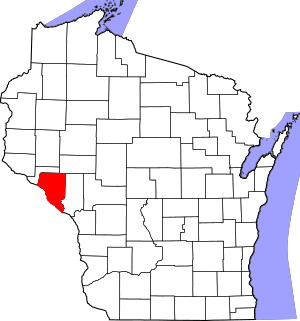National Register of Historic Places listings in Buffalo County, Wisconsin facts for kids
Welcome to Buffalo County, Wisconsin! This article is about some really special places here. These places are listed on the National Register of Historic Places. This means they are important buildings, areas, or sites that have a cool story from the past. They are protected so people can learn about history for many years to come.
There are 13 of these amazing historic spots in Buffalo County. Let's explore some of them!
Contents
- Historic Places in Alma
- Historic Places in Fountain City
- Historic Places in Waumandee
- Images for kids
Historic Places in Alma
Alma is a town with many historic buildings. It's located right between the Mississippi River and tall bluffs.
Alma Historic District
This is a whole area in Alma with over 100 historic buildings. Many of them were built between 1867 and 1889. This was a busy time when lots of trees were being cut down and floated down the river.
Jacob Berni House
A Home for a Hard Worker
This brick house was built in 1885. It has a special roof shape called a "gabled-ell." Jacob Berni was a very busy person! He was in charge of logging and timber rafting crews. This meant he helped cut down trees and float them on the river. He was also a farmer, led a cheese factory, and helped manage the school's money.
Burlington Hotel
A Hotel by the Tracks
Built in 1890, this two-story brick hotel has a fancy metal decoration called a zinc cornice. It was named after the Chicago, Burlington and Northern Railroad. The train station was right across the street, making it a perfect spot for travelers.
Frederick Laue House
A Lumber King's Home
This grand house was built in 1866. It's designed in a style called Italianate, which was popular back then. Frederick Laue owned the biggest lumber mill in Alma. He also helped start the Beef Slough Log Driving Company, which was important for moving logs.
Frederick Laue, Jr., House
A Son's Stylish House
Built in 1896, this house is in the Second Empire style. This style often has a special kind of roof called a mansard roof.
John L. Senn House
A Home with Fancy Details
This brick home was built in 1885. It has decorative wooden pieces on the gables (the triangular parts of the roof) called pierced barge boards.
Sherman House
A Hotel for River Travelers
This brick hotel was built in 1866. It was named after a famous general, William T. Sherman. The hotel was a busy place, serving farmers, lumber workers, and people who worked on the river.
John Steiner Store
A Store from the Past
This two-story brick store was built in 1887. It has a decorative top edge called a cornice. Imagine all the things people bought here long ago!
Dr. J. T. Tenny House
A Doctor's Queen Anne Home
This beautiful house was built in 1904. It's in the Queen Anne style, known for its fancy details and shingled walls. Dr. Tenny had it built for his new wife. A builder named Ulrich Walser constructed it.
Tester and Polin General Merchandise Store
Where Farmers Traded Goods
This 2.5-story brick store was built in 1861. Farmers would bring their crops and other goods here to trade for things they needed, like tools, clothes, or food. It was a very important place for the community.
Ulrich Walser House
A Builder's Own Home
Built in 1895, this house is also in the Queen Anne style. It has decorative bargeboards and a fancy front porch in the Eastlake style. Ulrich Walser was an immigrant builder from Switzerland, and he built this house for himself!
Historic Places in Fountain City
Fountain City is another town in Buffalo County with its own special historic sites.
Fugina House
A Judge's Modern Home
This house was built in 1916 and designed by Percy Dwight Bentley. It's in a style called Prairie School, which has strong horizontal lines. Martin Fugina grew up in Fountain City and became a lawyer and a county judge. He and his wife were very involved in their community.
Historic Places in Waumandee
Waumandee also has a unique historic building.
Harmonia Hall
A Place for German and Swiss Thinkers
This white wooden meeting house was built in 1890. It was used by a group called the Harmonie Gesellschaft, which means "Harmony Society." These were German and Swiss Freethinkers who met every month to talk and sing. The group started around 1861 and continued meeting until the 1950s.
Images for kids















